![]() Three weeks ago, we built a "hot box" that can maintain a small enclosure at a constant temperature in the order of 85°C during a few hours. This week, we are trying to do the opposite: a "cold box" that can maintain an ambient temperature in the order of -30°C.
Three weeks ago, we built a "hot box" that can maintain a small enclosure at a constant temperature in the order of 85°C during a few hours. This week, we are trying to do the opposite: a "cold box" that can maintain an ambient temperature in the order of -30°C.
The hot box is essentially a convection oven: two small halogen bulbs generate the heat and the hot air is moved by two fans. With this method, certainly somewhat crude, we manage without difficulty to reach a temperature difference with ambient air of about 65°C. So we asked ourselves if we couldn't do the exact same thing, but the other way around.
Dry ice
We had the idea of using dry ice instead of the halogen bulbs. Dry ice is simple carbon dioxide compressed to the point of turning solid. In this state, it stays at about -79°C until is slowly sublimates into carbon dioxide gas at ambient temperature and pressure. In small amounts, dry ice can even be delivered in the mail, at least in Switzerland. It comes in the shape of pellets in a large expanded polystyrene box. Stored outside at about 0°C (it's wintertime) in the original packaging, 6Kg of dry ice take about 4 days to completely evaporate. The dry ice costed us 50CHF, shipping included.
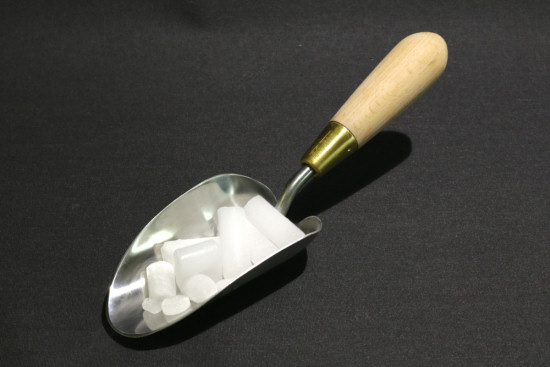
Dry ice pellets. Beware, it's cold.
Modifying the hot box
So we modified our hot box: we added a trapdoor in the central compartment to load the dry ice pellets and we isolated this compartment with a 15mm layer of expanded polystyrene.
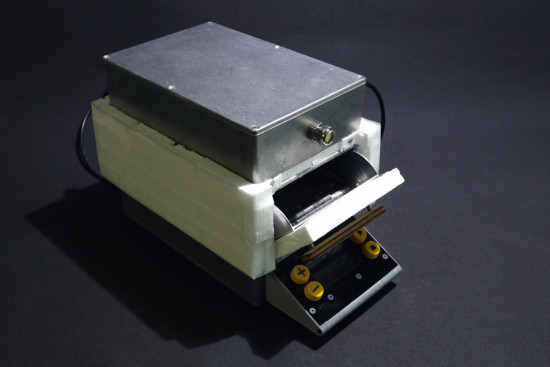
We added a small trapdoor to load the dry ice
As we couldn't really "turn off" the dry ice, we based our regulation on the fan action. We drive the fans with a Yocto-PowerRelay-V2. We start the fans to circulate the air cooled by pellets and thus lower the temperature in the top compartment. We rely on thermal losses of this top compartment for the temperature to rise again when the fans are off. As for the "hot" version, the regulation algorithm is based on a PID.
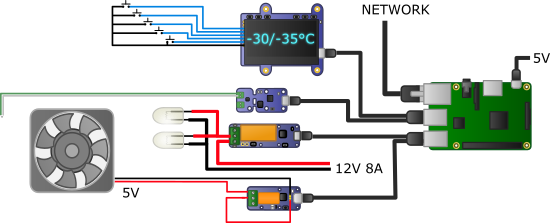
We simply added a relay to drive the fans
Note that we didn't remove the halogen bulbs. We were somewhat afraid that the thermal shock would make the bulb glass explode, but apparently bathing in dry ice at -80°C doesn't make them sweat. It's true that a halogen bulb is submitted to an enormous thermal shock each time it's turned on.
And does it work?
To everyone's surprise, this rudimentary system works extraordinarily well. In a room at 23°C, we managed to lower the temperature in the test area to about -38°C, so a delta of more than 60°C, and we can reach and maintain our target temperature of -30°C without any trouble. As soon as we turn the fans off, the temperature in the top compartment rises quickly.
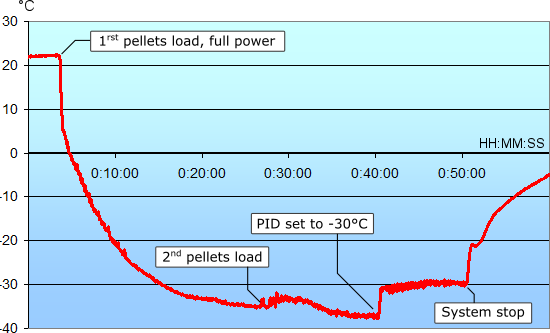
Test of the cold box
Opening the trapdoor during an experiment clearly makes the temperature rise a few degrees, degrees that can take time to lose again.The best technique is apparently to load the box with pellets, wait until the systems gets cold and the temperature gets slightly below the target temperature, then open the trapdoor again, load to the max, and only then start the experiment. In this way, we can maintain -30°C in the enclosure for about 90 minutes without having to reload.
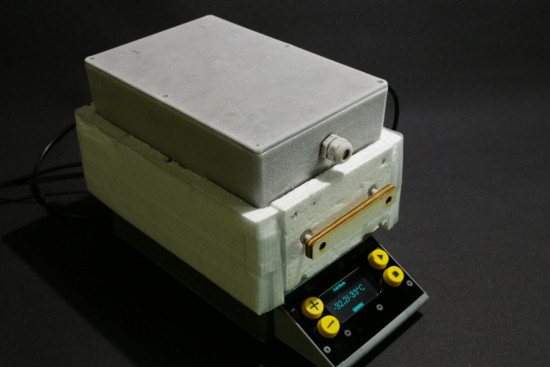
The working cold box
Possible improvements
Our aim was to maintain -30°C, we reached it without trouble. But if need be, we could probably improve the performances by isolating the sides of the top compartment. We could also use a better insulant than expanded polystyrene, such as a material based on aerogel.
Safety
Dry ice is a really fun material: it can generate extreme cold and if you put it in lukewarm water it transforms into a spectacular smoke-engine. However, don't forget that it's a relatively dangerous material.
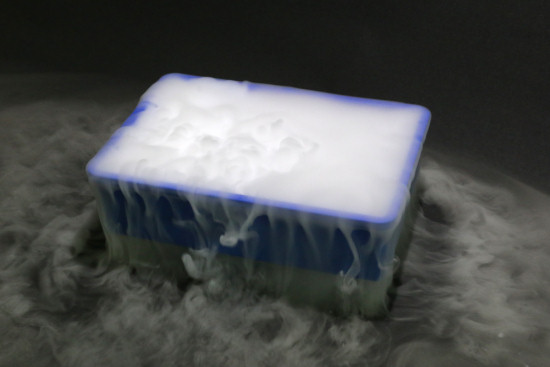
Dry ice + lukewarm water = instant fog
If you want to reproduce this experiment at home, pay close attention to the following points:
- -79°C is really very cold, use gloves and be careful of your eyes.
- When warming up, the dry ice frees important quantities of pure CO2, about 500 liters/Kg. This CO2, odorless, invisible and heavier than air, accumulates on the ground. CO2 starts to become really dangerous from a 3% concentration in the air and if you have the misfortune to enter a room saturated with CO2, you are going to faint and die before you know what happens to you. We advise you to work in a well ventilated room and to store your dry ice stock outside, in the open air.
- Whatever you do, never store dry ice in a hermetic container: the carbon dioxide gas released from the dry ice would make it burst. Using a thermos, for example, is a very bad idea.
Well, we are finally going to know if Yoctopuce modules work at -30°C...


